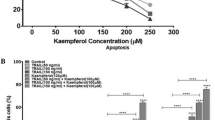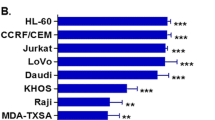Chemotherapeutic agent is characterized by its concentration in tumor cells with minimum side effects. Oleandrin, a polyphenolic cardiac glycoside is known to induce apoptosis in tumor cells. However, no report is available on its efficacy in primary cells. In this report we are providing the evidence that oleandrin induces apoptosis, not necrosis in tumor cells but not in primary cells like peripheral blood mononuclear cells (PBMC) and neutrophils. Oleandrin inhibited NF-κB activation in tumor cells but not in primary cells. It induced cell death in NF-κB-overexpressed tumor cells. Oleandrin induced Fas expression thereby inducing apoptosis in tumor cells but not in primary cells. Dominant negative FADD inhibited oleandrin-induced cell death in tumor cells. Overall, these results suggest that oleandrin mediates apoptosis in tumor cells by inducing Fas but not in primary cells indicating its potential anti-cancer property with no or slight side effect.






Similar content being viewed by others
Abbreviations
- FADD:
-
Fas-associated death domain
- GFP:
-
green fluorescent peptide
- IκBα:
-
inhibitory subunit of NF-κB
- IκBα-DN:
-
IκBα dominant negative
- LDH:
-
lactate dehydrogenase
- MDA:
-
malondialdehyde
- NF-κB:
-
nuclear transcription factor kappa B
- MTT:
-
3-(4,5-dimethyl-2-thiozolyl)-2,5-diphenyl-2H-tetrazolium bromide
- PARP:
-
poly-ADP ribose polymerase
- PBMC:
-
peripheral blood mononuclear cells
- PIS:
-
preimmune serum
- ROI:
-
reactive oxygen intermediates
- SA-LPS:
-
serum-activated lipopolysaccharide
- SEAP:
-
secretory alkaline phosphatase.
REFERENCES
Epinat JC, Gilmore TD: Diverse agents act at multiple levels to inhibit the Rel/NF-kappaB signal transduction pathway. Oncogene 18:6896–6909, 1999
Gupta RS, Chopra A: Cross-resistance and biochemical studies with two classes of HeLa cell mutants resistant to cardiac glycosides: The unusual behavior of cardenolide SC4453. J Biol Chem 260:6843–6850, 1985
Gupta RS, Chopra A, Stetsko DK: Cellular basis for the species differences in sensitivity to cardiac glycosides (digitalis). J Cell Physiol 127:197–206, 1986
Gupta RS, Chopra A: Human cell mutants affected in the interaction of the 12 β-OH group of cardiac glycosides with the digitalis receptor. Biochem Pharmacol 36:3829–3833, 1987
Smith JA, Madden T, Vijjeswarapu M, Newman RA: Inhibition of export of fibroblast growth factor-2 (FGF-2) from the prostate cancer cell lines PC3 and DU145 by Anvirzel and its cardiac glycoside component, oleandrin. Biochem Pharmacol 62:469–472, 2000
Wang CY, Guttridge DC, Mayo MW, Baldwin AS Jr: NF-κB induces expression of the Bcl-2 homologue A1/Bfl-1 to preferentially suppress chemotherapy-induced apoptosis. Mol Cell Biol 19:5923–5929, 1999
Waddick KG, Uckun FM: Innovative treatment programs against cancer. II. Nuclear factor-kappa B (NF-κB) as a molecular target. Biochem Pharmacol 57:9–17, 1999
Karin M, Liu ZG, Zandi E: AP-1 function and regulation. Curr Opin Cell Biol 9:240–246, 1997
Chung JY, Huang C, Meng X, Dong Z, Yang CS: Inhibition of activator protein 1 activity and cell growth by purified green tea and black tea polyphenols in H-ras-transformed cells: Structure–activity relationship and mechanisms involved. Cancer Res 59:4610–4617, 1999
Sen R, Baltimore D: Inducibility of kappa immunoglobulin enhancer-binding protein NF-kappa B by a posttranslational mechanism. Cell 47:921–928, 1986
Bours V, Bentires-Alj M, Hellin AC, et al.: Nuclear factor-kappa B, cancer, and apoptosis. Biochem Pharmacol 60:1085–1089, 2000
Dhawan P, Richmond A: A novel NF-kappa B-inducing kinase-MAPK signaling pathway up-regulates NF-kappa B activity in melanoma cells. J Biol Chem 27:7920–7928, 2002
Kochetkova M, Iversen PO, Lopez AF, Shannon MF: Deoxyribonucleic acid triplex formation inhibits granulocyte macrophage colony-stimulating factor gene expression and suppresses growth in juvenile myelomonocytic leukemic cells. J Clin Invest 99:3000–3008, 1997
Baeuerle PA, Baichwal VR: NF-κB as a frequent target for immuno-suppressive and anti-inflammatory molecules. Adv Immunol 65:111–137, 1997
Baichwal VR, Baeuerle PA: Activate NF-κB or die? Curr Biol 7:R94-R96, 1997
Wang CY, Mayo MW, Baldwin AS Jr: TNF- and cancer therapy-induced apoptosis: Potentiation by inhibition of NF-κB. Science 274:784–787, 1996
Van Antwerp DJ, Martin SJ, Kafri T, Green DR, Verma IM: Suppression of TNF-α-induced apoptosis by NF-κB. Science 274:787–789, 1999
Wang CY, Cusack JC Jr, Liu R, Baldwin AS Jr: Control of inducible chemoresistance: Enhanced anti-tumor therapy through increased apoptosis by inhibition of NF-κB. Nat Med 5:412–417, 1999
Giri DK, Aggarwal BB: Constitutive activation of NF-κB causes resistance to apoptosis in human cutaneous T cell lymphoma HuT-78 cells: Autocrine role of tumor necrosis factor and reactive oxygen intermediates. J Biol Chem 273:4008–14014, 1998
Nakshatri H, Bhat-Nakshatri P, Martin DA, Gouletm RJ Jr, Sledge GW Jr: Constitutive activation of NF-kappaB during progression of breast cancer to hormone-independent growth. Mol Cell Biol 17:3629–3639, 1997
Manna SK, Aggarwal BB: Lipopolysaccharide inhibits TNF-induced apoptosis: Role of nuclear factor-kappaB activation and reactive oxygen intermediates. J Immunol 162:1510–1518, 1999
Manna SK, Zhang HJ, Yan T, Oberley LW, Aggarwal BB: Overexpression of Mn-superoxide dismutase suppresses TNF induced apoptosis and activation of nuclear transcription factor-B and activated protein-1. J Biol Chem 273:13245–13254, 1998
Manna SK, Kuo MT, Aggarwal BB: Overexpression of γ-glutamylcysteine synthetase abolishes tumor necrosis factor-induced apoptosis and activation of nuclear transcription factor-B and activator protein-1. Oncogene 18:4371–4382, 1999
Li N, Karin M: Is NF-κB the sensor of oxidative stress? FASEB J 13:1137–1143, 1999
Kumar A, Aggarwal BB: Assay for redox sensitive kinases. Methods Enzymol 300:339–345, 1999
Toillon RA, Descamps S, Adriaenssens E, Ricort JM, Bernard D, Boilly B, Le Bourhis X: Normal breast epithelial cells induce apoptosis of breast cancer cells via Fas signaling. Exp Cell Res 275:31–43, 2002
Manna SK, Samanta S, Samanta AK: Hamycin inhibits IL-8-induced biological response by modulating its receptor in human polymorphonuclear neutrophils. J Immunol 159:5042–5052, 1997
Sarkar A, Sreenivasan Y, Ramesh GT, Manna SK: beta-D-Glucoside suppresses tumor necrosis factor-induced activation of nuclear transcription factor kappaB but potentiates apoptosis. J Biol Chem 279:33768–33781, 2004
Lu Q-P, Tian L: Fas mRNA expression and calcium influx change in H2O2-induced apoptotic hepatocytes in vitro. World J Gastroenterol 11:534–537, 2005
Manna SK, Sarkar A, Sreenivasan Y: α-Melanocyte Stimulating Hormone downregulates CXC receptors through activation of neutrophil elastase. Eur J Immunol 36:754–769, 2006
Meinhold-Heerlein I, Stenner-Liewen F, Liewen H, Kitada S, Krajewska M, Krajewski S, Zapata JM, Monks A, Scudiero DA, Bauknecht T, Reed JC: Expression and potential role of Fas-associated phosphatase-1 in ovarian cancer. Am J Pathol 158:1335–1344, 2001
Manna SK, Mukhopadhyay A, Van NT, Aggarwal BB: Silymarin suppresses TNF-induced activation of nuclear transcription factor-[{kappa}]B, c-Jun N terminal kinase, and apoptosis. J Immunol 162:6800–6809, 1999
Manna P, Narang KK, Manna SK: 1,2,4-Thiadiazolidine derivative inhibits nuclear transcription factor-κB and its dependent genes activation but induces apoptosis. Int J Cancer 113:549–560, 2005
Goel A, Dispenzieri A, Greipp PR, Witzig TE, Mesa RA, Russell SJ: PS-341-mediated selective targeting of multiple myeloma cells by synergistic increase in ionizing radiation-induced apoptosis. Exp Hematol 33:784–795, 2005
Sreenivasan Y, Sarkar A, Manna SK: Oleandrin suppresses activation of nuclear transcription factor-kappaB and activator protein-1 and potentiates apoptosis induced by ceramide. Biochem Pharmacol 66:2223–2239, 2003
Manna SK, Ramesh GT: Interleukin-8 induces nuclear transcription factor-{kappa}B through a TRAF6-dependent Pathway. J Biol Chem 280:7010–7021, 2005
McConkey DJ, Lin Y, Nutt LK, Ozel HZ, Newman RA: Cardiac glycosides stimulate Ca2+ increases and apoptosis in androgen-independent, metastatic human prostate adenocarcinoma cells. Cancer Res 60:3807–3812, 2000
Pathak S, Multani AS, Narayan S, Kumar V, Newman RA: Anvirzel, an extract of Nerium oleander, induces cell death in human but not murine cancer cells. Anticancer Drugs 11:455–463, 2000
Dong G, Chen Z, Kato T, Van Waes C: The host environment promotes the constitutive activation of nuclear factor-κB and proinflammatory cytokine expression during metastatic tumor progression of murine squamous cell carcinoma. Cancer Res 59:3495–3504,. 1999
Manna SK, Sreenivasan Y, Sarkar A: Cardiac glycoside inhibits IL-8-induced biological responses by downregulating IL-8 receptors through altering membrane fluidity. J Cell Physiol 207:195–207, 2006
Manna SK, Sah NK, Newman A, Cisneros A, Aggarwal BB: Oleandrin suppresses activation of nuclear transcription factor-[{kappa}]B, activator protein-1, and c-Jun NH2-terminal kinase. Cancer Res 60:3838–3847, 2000
Raoul C, Pettmann B, Henderson CE: Active killing of neurons during development and following stress: A role for p75(NTR) and Fas? Curr Opin Neurobiol 10:111–117, 2000
ACKNOWLEDGMENTS
The Department of Biotechnology (DBT), Government of India supported this work. We duly acknowledge Department of Science and Technology (DST) for providing SEARC Fast Track proposal for Young Scientists grant to SM, and Council for Scientific and Industrial Research (CSIR), New Delhi for providing fellowship for YS.
Author information
Authors and Affiliations
Corresponding author
Additional information
A retraction note to this article is available at http://dx.doi.org/10.1007/s10875-013-9884-3.
This article has been retracted at the request of the Centre for DNA Fingerprinting and Diagnostics as it contains manipulated figures.
An erratum to this article is available at http://dx.doi.org/10.1007/s10875-013-9884-3.
About this article
Cite this article
SREENIVASAN, Y., RAGHAVENDRA, P.B. & MANNA, S.K. RETRACTED ARTICLE: Oleandrin-Mediated Expression of Fas Potentiates Apoptosis in Tumor Cells. J Clin Immunol 26, 308–322 (2006). https://doi.org/10.1007/s10875-006-9028-0
Received:
Accepted:
Published:
Issue Date:
DOI: https://doi.org/10.1007/s10875-006-9028-0




